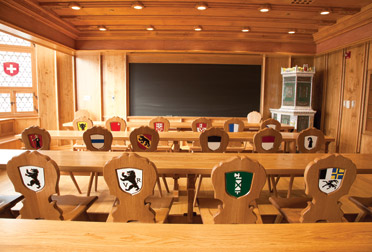Home ›
And then there were 29…Pitt Dedicates Swiss Room
Issue Date:
April 4, 2012  The University of Pittsburgh Swiss Nationality Room was dedicated April 22 during a ceremony in Heinz Chapel, followed by a reception in the Cathedral of Learning Commons Room. Planning for the room—the 29th of Pitt’s renowned collection of ethnic classrooms—began in 1988 with the formation of the Swiss Nationality Room Committee. Heinz W. Kunz, Pitt emeritus faculty member and former honorary consul for Switzerland in Pittsburgh, chairs the committee; Pittsburgh Steelers quarterback Ben Roethlisberger is an honorary member. The Swiss Room design was inspired by a room from Fraumünster Abbey in Zürich, built in 1489. The classroom features four handmade trestle tables and 26 “Stabellen” chairs, representing Switzerland’s four linguistic regions and 26 “cantons” (states). Stained-glass windows display the coats of arms of Switzerland’s first cantons, which united in 1291 to form the nucleus of what would become today’s Swiss Confederation. A hand-carved-and-painted frieze encircles the classroom and includes representations of the flora, fauna, and people of Switzerland.
The University of Pittsburgh Swiss Nationality Room was dedicated April 22 during a ceremony in Heinz Chapel, followed by a reception in the Cathedral of Learning Commons Room. Planning for the room—the 29th of Pitt’s renowned collection of ethnic classrooms—began in 1988 with the formation of the Swiss Nationality Room Committee. Heinz W. Kunz, Pitt emeritus faculty member and former honorary consul for Switzerland in Pittsburgh, chairs the committee; Pittsburgh Steelers quarterback Ben Roethlisberger is an honorary member. The Swiss Room design was inspired by a room from Fraumünster Abbey in Zürich, built in 1489. The classroom features four handmade trestle tables and 26 “Stabellen” chairs, representing Switzerland’s four linguistic regions and 26 “cantons” (states). Stained-glass windows display the coats of arms of Switzerland’s first cantons, which united in 1291 to form the nucleus of what would become today’s Swiss Confederation. A hand-carved-and-painted frieze encircles the classroom and includes representations of the flora, fauna, and people of Switzerland.Other Stories From This Issue
There are no stories for the issue at this time.
On the Freedom Road

Follow a group of Pitt students on the Returning to the Roots of Civil Rights bus tour, a nine-day, 2,300-mile journey crisscrossing five states.
Day 1: The Awakening
Day 2: Deep Impressions
Day 3: Music, Montgomery, and More
Day 4: Looking Back, Looking Forward
Day 5: Learning to Remember
Day 6: The Mountaintop
Day 7: Slavery and Beyond
Day 8: Lessons to Bring Home
Day 9: Final Lessons

